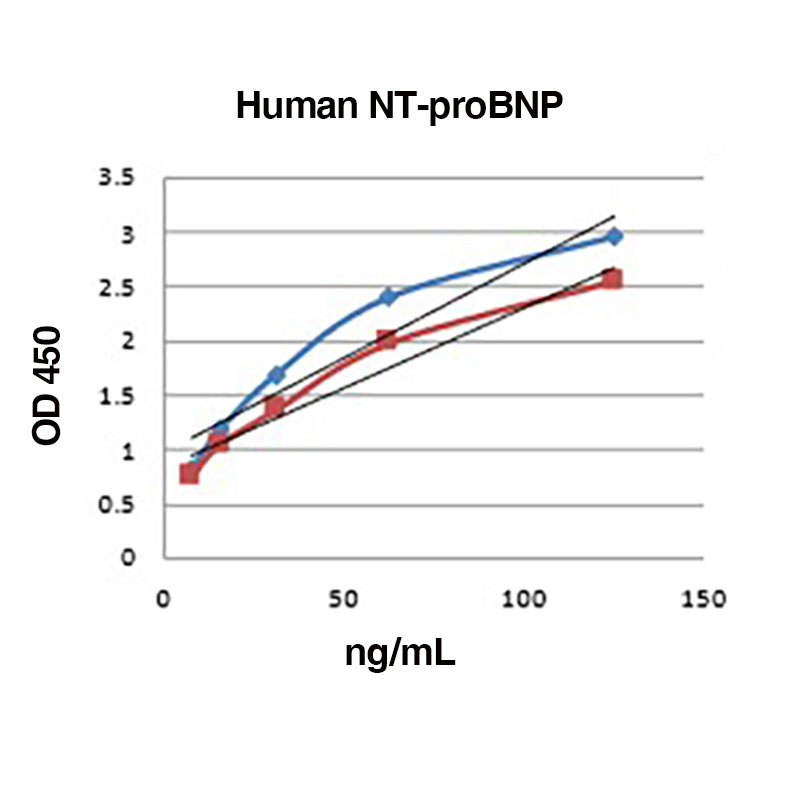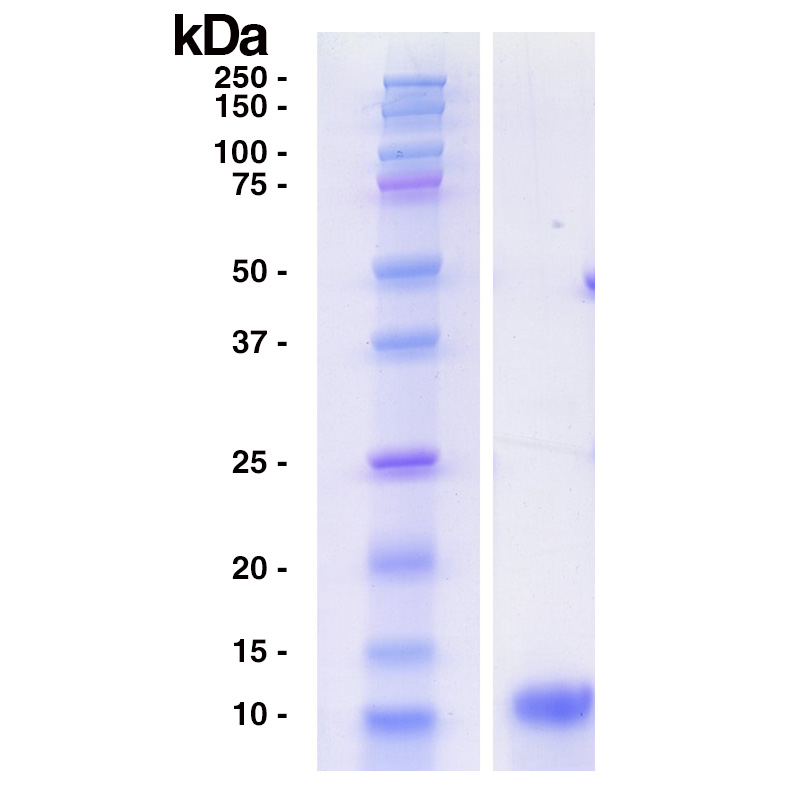Human NT-proBNP
Data
- -
- -
BackgroundN-terminal pro-brain natriuretic peptide (NT-proBNP) is widely used as a diagnostic biomarker
for heart failure and cardiac dysfunction in both clinical and forensic settings1. NT-proBNP is
found in plasma1 and urine2 after being synthesized and secreted by myocytes in the left
ventricle in response to pressure overload or ventricular volume expansion1. Mechanical stress induces the BNP promoter via p38 MAPK signaling, and a 134 aa BNP precursor (pre-proBNP) is rapidly translated from the unstable RNA1. Subsequently, proBNP is formed by removing a 26 aa N-terminal signal peptide. ProBNP is then split into the 76 aa NT- proBNP and 32 aa BNP, which has diuretic, natriuretic, and vasodilatory effects. BNP and NT- proBNP have a half-life of ~20 and 90-120 minutes, respectively. Additionally, NT-proBNP remains elevated for ~12 weeks post myocardial infarction. BNP and NT-proBNP are used as biomarkers to diagnose the severity of heart failure and cardiac dysfunction as well as to guide treatment strategies1. The upper limit for normal in the non-acute setting is 35 pg/mL for BNP and 125 pg/mL for NT-proBNP, and 100 pg/mL and 300 pg/mL in the acute setting, respectively. Additionally, age-dependent cutoffs for NT-proBNP can be used to diagnose heart failure (patients <50 years with levels >450 pg/mL; 50-75 years with levels >900 pg/mL; >75 years with levels >1800 pg/mL). NT-proBNP is also related to arrhythmias and cardiomyopathies and is increased in atrial fibrillation patients1. Additionally, there is a positive correlation between NT-proBNP levels and the risk of death, and a reduction in NT-proBNP levels predicts an improvement in clinical symptoms. As such, NP-proBNP is a useful diagnostic indicator to manage patient treatment. NP-proBNP is also useful in forensic pathology to clarify the mechanism of death; NT-proBNP is stable for at least 24 days postmortem. Protein DetailsSpecies Human Format Purified No Carrier Protein Protein Accession No. P16860 Amino Acid Sequence HPLGSPGSAS DLETSGLQEQ RNHLQGKLSE LQVEQTSLEP LQESPRPTGV WKSREVATEG IRGHRKMVLY TLRAPR State of Matter Liquid SDS-Page Molecular Weight ~10kDa Predicted Molecular Mass ~9.5kDa Storage and Stability 1 month, 2 to 8 °C under sterile conditions after opening.
1 year from date of receipt, -20 to -80 °C as supplied.
3 months from date of receipt, -20 to -80 °C sterile conditions after opening Country of Origin USA Shipping Frozen Dry Ice Species Human Regulatory Status Research Use Only NCBI Gene Bank UniProt.org Applications and Recommended Usage ? (Quality Tested by Leinco) ELISA, WB References & Citations1 Cao Z, Jia Y, Zhu B. Int J Mol Sci. 20(8):1820. 2019. 2 Müller N, Bayer E, Bernhardt C, et al. Clin Chim Acta. 529:4-9. 2022. 3 Seferian KR, Tamm NN, Semenov AG, et al. Clin Chem. 54(5):866-873. 2008. 4 Chen YY, Li SL, Lin HL, et al. Anal Biochem. 611:113950. 2020. 5 Srisujikul P, Thiankhaw K, Tanprawate S, et al. Sci Rep. 13(1):13903. 2023. 6 Colom G, Salvador JP, Acosta G, et al. Analyst. 145(20):6719-6727. 2020. Technical ProtocolsCertificate of AnalysisIMPORTANT Use lot specific datasheet for all technical information pertaining to this recombinant protein. |




